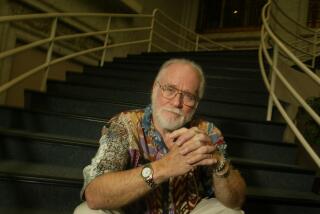Historic theater in Beverly Hills an empty shell
The renowned designer had a mission: to “transform this Wilshire Boulevard cracker box into a sumptuous palace.”
So Joseph J. Musil ordered up red velour seats, gold sconces, a sunburst ceiling and a lobby carpeted in crimson for the 1993 renovation of the Fine Arts Theater in Beverly Hills. Shimmery black curtains swept back to reveal the giant screen. The place thrived as a venue for small premieres, drawing A-listers on any given night and plaudits from nearby residents.
But it wasn’t enough. Unable to stay afloat, the Fine Arts closed in 2009. An Indian company’s plan to reopen it to screen Bollywood films fell through. The theater became an empty shell.
And so it remains. Some supporters worry that the Fine Arts will never function as a theater again. Back on the market for $4 million, the Fine Arts is at the mercy of an era and economy that make a tiny, one-screen movie theater a risky investment. And while former patrons view the theater with nostalgia, and a few prospective buyers have made inquiries, no investors have stepped up. Historic as the theater is, it is not quite a landmark.
“It’s a big shame, but you know, it’s a change in the entertainment system,” said Brian Dunne of NAI Capital, who has the listing. “People are going to the big multiplexes with food courts and parking. They want it to be more of a social experience. I don’t mean to say this is a dinosaur going nowhere. This place has a lot of charms. We need somebody who wants to keep its tradition alive.”
That tradition dates to 1936, when it was built. Named the Regina Theater, it would go on to generate a wealth of lore. Actor Peter Lorre once stopped in to catch a showing of “M,” the German film that kick-started his career. He fell asleep.
In 1948 it was renamed the Fine Arts Theater and hosted the premiere of “The Red Shoes.” Invited guests included Susan Hayward, Joan Crawford, Ava Gardner and Shirley Temple.
Vittorio Cecchi Gori’s film production company bought the theater in the early 1990s and spearheaded the Musil renovation. Cecchi Gori’s 1997 production “Life Is Beautiful” went on to win several Oscars. Its director and star, Roberto Benigni, arrived one day at the Fine Arts to practice crawling over theater seats, a move he repeated the following evening at the Dorothy Chandler Pavilion when accepting his best actor award.
Known as a low-key place that showed foreign films or indie flicks, the Fine Arts attracted cinephiles and celebrities.
Casey Rocke, who worked as the theater’s manager and film projectionist, recalled the days when Mel Brooks and Anne Bancroft arrived on double dates with Carl and Estelle Reiner. An employee once jokingly carded Charlton Heston for the senior discount. Even Hollywood’s younger generation made their way to the ticket booth. Cameron Diaz and Leonardo DiCaprio were both good-humored during its pre-credit card days, dashing to an ATM across the street.
“We had a solid audience and always booked something no one else had,” Rocke, 34, said. “The theater didn’t make a killing, but it didn’t lose money.”
At one point Landmark Theatres was operating the place; then Cecchi Gori rented it out as a screening room. The current owner, Bhupendra Kumar Modi, who lives in Singapore and has a home in Beverly Hills, is selling the Fine Arts after deciding its operation didn’t fit his company’s business plan.
City officials and staff have spoken in favor of keeping the site a cinema. Michele McGrath, senior planner for Beverly Hills, said city officials have been looking at how to invigorate the neighborhood and have even talked of creating a theater district.
“I think the city cares about theaters in general — they’re part of our cultural heritage,” she said.
Area residents say they have felt the loss. But most see it simply as a sign of the times.
“It seemed like it was part of our neighborhood and that we had a stake in it,” said Brenda Castiel, who has lived within walking distance of the theater for two decades. “I would love for it to remain a theater, but I imagine it’s not economically viable.”
Across from a gas station and an auto repair shop just west of La Cienega Boulevard, the theater is easy to miss on traffic-clogged Wilshire Boulevard. Display cases that once held movie posters are empty and the marquee blank.
Inside, boxes of Red Vines and Junior Mints still linger at the concession stand. A purple couch fringed in gold awaits a visitor. Although the entry shows some wear and tear, the auditorium, with its rows of plush seats and gold and silver decor, still exudes glamour. It is in need of a ruler but remains the sumptuous palace Musil envisioned.
More to Read
Start your day right
Sign up for Essential California for news, features and recommendations from the L.A. Times and beyond in your inbox six days a week.
You may occasionally receive promotional content from the Los Angeles Times.







